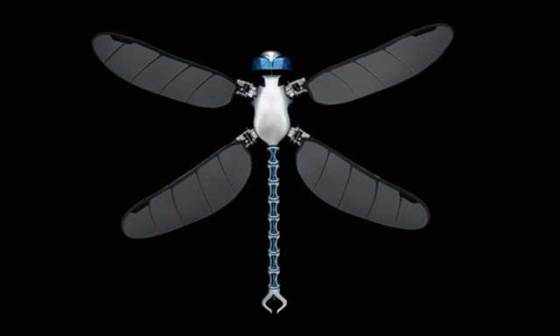Festo BionicOpter robot dragonfly
 After devising systems inspired by penguins, herring gulls and elephant trunk, engineers at Festo devised a new system suitable for their Bionic Learning Network project. Inspired by dragonflies, they developed BionicOpter – an ultra-light system packed with everything needed to mimic the way dragonflies maneuver in all directions, glide without having to beat their wings and hover in the air.
After devising systems inspired by penguins, herring gulls and elephant trunk, engineers at Festo devised a new system suitable for their Bionic Learning Network project. Inspired by dragonflies, they developed BionicOpter – an ultra-light system packed with everything needed to mimic the way dragonflies maneuver in all directions, glide without having to beat their wings and hover in the air.
The ability to move their two pairs of wings independently enables dragonflies to slow down and turn abruptly, to accelerate swiftly and even to fly backwards. Festo engineers designed BionicOpter with the ability to controlling the flapping frequency and the twisting of the individual wings, as well as with an amplitude controller on each wing. This means that the direction of thrust and the intensity of thrust for all four wings can be adjusted individually, thus enabling flight in almost any orientation in space.
With a wingspan of 70cm (27.55 inches) and a body length of 48cm (18.8 inches), the model dragonfly weighs just 175 grams (6.17 ounces). The wings consist of a carbon fiber frame and a thin foil covering. The structure is made of flexible polyamide and terpolymer. This makes the entire system flexible and ultra-light, but still sturdy. The small ribcage houses the battery, nine servo motors, sensory and wireless modules, and a high-performance ARM microcontroller.
The body of the dragonfly is fitted with four flexible muscles made of nitinol. These shape memory alloys (SMAs) contract when exposed to heat and expand when they cool down. Passing an electric current through the SMAs produces ultra-light actuators that move the head horizontally and the tail vertically.
During operation, the remote-control system simply transfers the signals that tell the object which direction to fly in and at what speed. The microcontroller calculates all the parameters that can be adjusted mechanically based on the recorded fight data and the pilot’s input. The processor actuates the nine servo motors to translate these parameters into movement using beat frequency, a swivel device and the amplitude controller.
In order to stabilize the flying object, data on the position and the twisting of the wings is continuously recorded and evaluated in real time during the dragonfly’s fight. The acceleration and tilting angle of the BionicOpter in space can be measured using the inertia sensors. The integrated position and acceleration sensors detect the speed and spatial direction of the dragonfly’s fight.
BionicOpter can be operated easily and intuitively via a smartphone. The flapping frequency, amplitude and installation angle are controlled by software and electronics. The pilot just has to steer the dragonfly – there is no need to coordinate the complex motion sequences. The intelligent kinematics correct any vibrations during fight and ensure fight stability both indoors and outdoors.










Leave your response!